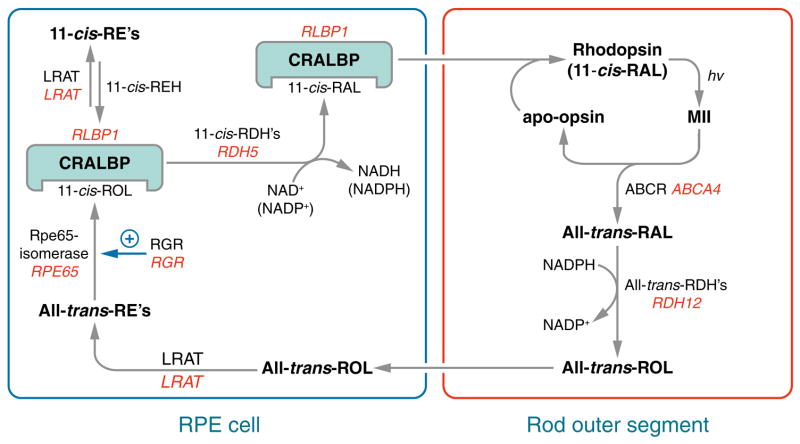Figure 2.
Visual cycle in retinal pigment epithelium (RPE) cells. Absorption of a photon (hv) by a rhodopsin pigment molecule induces isomerization of 11-cis-RAL to all-trans-RAL resulting in activated metarhodopsin II (MII). Decay of MII yields apo-opsin and free all-trans-RAL. Translocation of all-trans-RAL from the disc membrane to the cytoplasmic space is facilitated by an ATP-binding cassette transporter called ABCR or ABCA4. Mutations in the human ABCA4 gene cause recessive Stargardt macular degeneration. The all-trans-RAL is reduced to all-trans-retinol (all-trans-ROL) by two or more all-trans-ROL dehydrogenases (all-trans-RDHs). Mutations in the gene for one (RDH12) cause Leber congenital amaurosis (LCA) (85). The all-trans-ROL is released by photoreceptors and taken up by RPE cells where it is esterified to a fatty acid by lecithin:retinol acyl transferase (LRAT). Mutations in the LRAT gene cause a severe form of recessive retinitis pigmentosa (RP) (86). The isomerase, RPE-specific 65 kDa protein (Rpe65) uses an all-trans-retinyl ester as substrate to form 11-cis-retinol (11-cis-ROL) plus a free fatty acid. Mutations in the RPE65 gene also cause LCA (87, 88). The Rpe65 isomerase activity may be regulated by the non-photoreceptor opsin, RGR (131). Mutations in the RPE-retinal G protein-coupled receptor (RGR) gene also cause recessive RP (93). 11-cis-ROL binds to the cellular retinaldehyde-binding protein (CRALBP). Mutations in the gene for CRALBP (RLBP1) cause still another form of recessive RP (137). 11-cis-ROL may be esterified by LRAT to yield 11-cis-retinyl esters, a stable storage-form of pre-isomerized retinoid. 11-cis-retinyl esters are hydrolyzed to 11-cis-ROL for synthesis of chromophore by 11-cis-retinyl ester hydrolase (11-cis-REH), which has not yet been cloned. 11-cis-ROL is oxidized to 11-cis-RAL by several 11-cis-ROL dehydrogenases (11-cis-RDHs), including RDH5 and RDH11. Mutations in the gene coding for RDH5 cause delayed dark adaptation and a mild retinal dystrophy called fundus albipunctatus in humans (141). 11-cis-RAL is also bound to CRALBP before being released by the RPE and taken up by the photoreceptor where it recombines with opsin to form rhodopsin.

